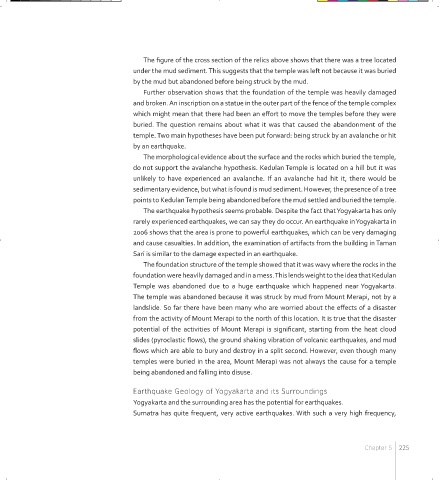Page 225 - THE MELANESIA DIASPORA FILE CETAK ISI 10022017
P. 225
The figure of the cross section of the relics above shows that there was a tree located
under the mud sediment. This suggests that the temple was left not because it was buried
by the mud but abandoned before being struck by the mud.
Further observation shows that the foundation of the temple was heavily damaged
and broken. An inscription on a statue in the outer part of the fence of the temple complex
which might mean that there had been an effort to move the temples before they were
buried. The question remains about what it was that caused the abandonment of the
temple. Two main hypotheses have been put forward: being struck by an avalanche or hit
by an earthquake.
The morphological evidence about the surface and the rocks which buried the temple,
do not support the avalanche hypothesis. Kedulan Temple is located on a hill but it was
unlikely to have experienced an avalanche. If an avalanche had hit it, there would be
sedimentary evidence, but what is found is mud sediment. However, the presence of a tree
points to Kedulan Temple being abandoned before the mud settled and buried the temple.
The earthquake hypothesis seems probable. Despite the fact that Yogyakarta has only
rarely experienced earthquakes, we can say they do occur. An earthquake in Yogyakarta in
2006 shows that the area is prone to powerful earthquakes, which can be very damaging
and cause casualties. In addition, the examination of artifacts from the building in Taman
Sari is similar to the damage expected in an earthquake.
The foundation structure of the temple showed that it was wavy where the rocks in the
foundation were heavily damaged and in a mess. This lends weight to the idea that Kedulan
Temple was abandoned due to a huge earthquake which happened near Yogyakarta.
The temple was abandoned because it was struck by mud from Mount Merapi, not by a
landslide. So far there have been many who are worried about the effects of a disaster
from the activity of Mount Merapi to the north of this location. It is true that the disaster
potential of the activities of Mount Merapi is significant, starting from the heat cloud
slides (pyroclastic flows), the ground shaking vibration of volcanic earthquakes, and mud
flows which are able to bury and destroy in a split second. However, even though many
temples were buried in the area, Mount Merapi was not always the cause for a temple
being abandoned and falling into disuse.
Earthquake Geology of Yogyakarta and its Surroundings
Yogyakarta and the surrounding area has the potential for earthquakes.
Sumatra has quite frequent, very active earthquakes. With such a very high frequency,
Chapter 5 225
MELANESIA BOOK FA LAYOUT 051216.indd 225 2/10/17 2:11 PM

